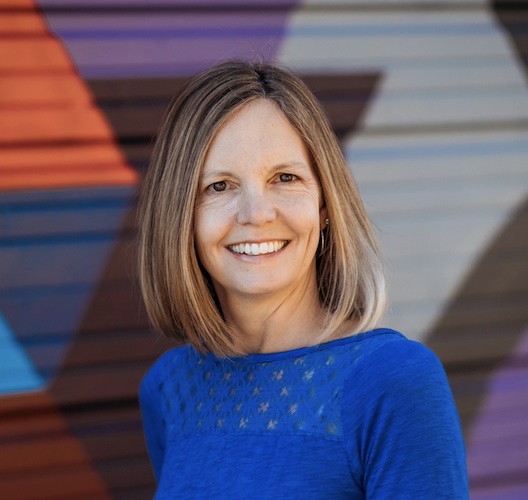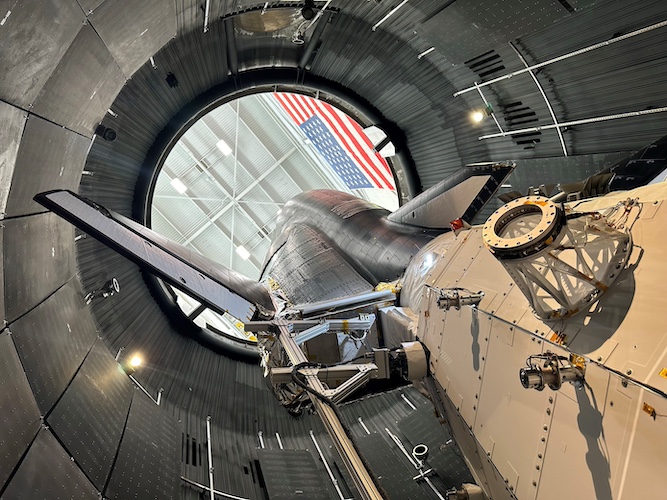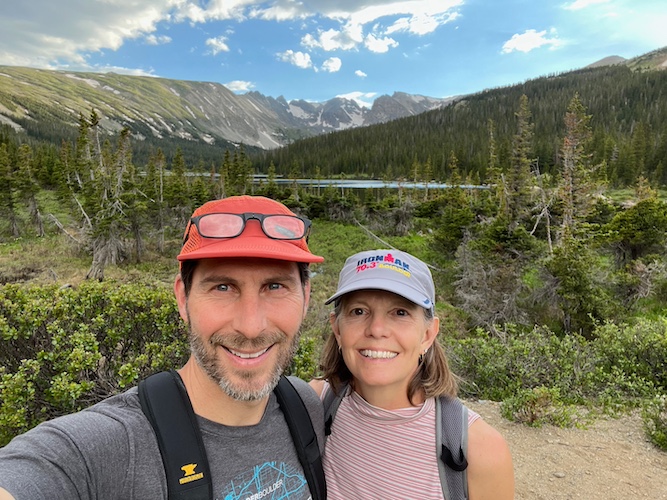Chasing Dreams
Alumni couple builds careers in space exploration and the arts
August 5, 2024
By
Tina Eshleman
Dan Polis ’93 is working to expand humans’ access to outer space. Crystal Anderson Polis ’93 helps museums and nonprofits convert vision into reality. Both say that William & Mary was instrumental in setting them on their chosen path.
As vice president of engineering solutions at Sierra Space, Dan leads an advanced manufacturing, materials and process, and engineering-services group for the company, which is preparing to launch its first commercial spaceplane in the next few months. Tenacity, Sierra Space’s inaugural Dream Chaser spacecraft, will mate with the company’s Shooting Star cargo module to transport supplies and experiments to and from the International Space Station. The uncrewed Dream Chaser is designed with the capability of landing on a runway anywhere in the world upon its return.

Eventually, the company aims to establish its own space station where travelers could visit and where corporate and academic researchers can conduct experiments and develop new medical therapies in a weightless environment.
“Sierra Space’s motto is ‘Building a platform in space to benefit life on Earth,’” Polis says. “What new drugs can we untap that can help humanity? What alternative energy sources?"
Enabling human travel and research outside Earth’s atmosphere also has value beyond an immediate return on investment, he adds, because it increases humanity’s understanding of the universe.
Crystal spent much of her career working in museums, starting out at the Smithsonian’s National Museum of American History, thanks to an internship she found out about at William & Mary’s career center (now called the Office of Career Development & Professional Engagement). In 2020, she started her own consulting business, focusing on grant writing and bookkeeping for nonprofits. Through Polis Consulting, “I help small- and medium-sized art organizations and other social justice nonprofits get funding,” she says.
INFLUENTIAL FACULTY
The Polises say mentors at William & Mary helped direct them toward their respective careers.
“When you’re growing up, you don’t know what jobs are out there, and working in museums or grant writing wasn't something I even knew you could do,” Crystal says. “William & Mary was responsible for exposing me to that.”
Her pursuit of both English and history studies caught the attention of Richard Lowry, a professor of English and now vice dean of arts, humanities and interdisciplinary studies.

“I remember Professor Lowry saying, ‘Do you know, you’ve basically created your own American studies curriculum? We have that here at William & Mary and you should consider graduate school for that.’” She went on to earn a master’s degree in American civilization from The George Washington University.
As part of an American studies course she took during her last semester at W&M, Crystal visited the Maryland Historical Society (now the Maryland Center for History and Culture) in Baltimore. The museum had invited Fred Wilson to come in and reinterpret its collection from the perspective of a Black artist. The resulting groundbreaking exhibition, “Mining the Museum,” displayed artwork and artifacts in nontraditional ways — such as placing a painting in a dark area and shining a light just on one enslaved child in the background, and displaying shackles along with candlesticks and horseshoes with the label “18th-century metalwork.” The exhibition made a lasting impression on her.
“It made you think about people making slave shackles at the same time as they’re making candlesticks,” she says. “It challenged the way you look at everyday objects and forced you to confront the legacy of violence. I thought at the time, ‘This is important work, and I want to be a part of it.’”
Dan started out as a math major at William & Mary, but changed direction after taking a general chemistry class.
“The chairman of the department came to find me and said something along the lines of, “I think you’re in the wrong major. You did really well in my class, and I think you should consider a chemistry major.’ And that was all it took,” he says. “I switched to chemistry.”
Dan was offered a chance to do research during the summer after his sophomore year with David E. Kranbuehl, now a professor emeritus.
“That year, I published a paper with him — for NASA-funded research, it turns out — in an area that, 10 years later, I got heavily involved with to develop cutting-edge spacecraft at NASA,” he says.
A NEW MISSION
After earning a doctorate in materials science at the University of Pennsylvania, Dan worked as a materials engineer, first at General Electric and then at the NASA Goddard Space Flight Center in Greenbelt, Maryland. His first project at NASA was designing and building a carrier to take instruments to the Hubble Space Telescope on the Space Shuttle, which was in low Earth orbit — defined as within an altitude of 1,200 miles. The carrier was built from advanced carbon fiber composite materials such as those used in skis and mountain bikes. Next, he led internal and external teams that investigated high-risk materials issues in preparation for the 2021 launch of the James Webb Space Telescope, which is much farther from Earth than the Hubble.
“My job kept getting more fulfilling at NASA, but eventually I didn’t see that next one-of-kind mission coming down the pipeline,” he says. About 12 years ago, he heard about an opportunity with Sierra Nevada Corp., a small Colorado-based company that was building a mini space shuttle, and the Polis family moved west.

“At Sierra Nevada, we were trying to develop what I call the ‘Uber’ to take crews to and from the International Space Station,” he says. The company won a series of development contracts, but lost the final contract award from NASA to Boeing and SpaceX.
It was a discouraging setback, but Polis and his colleagues were confident their spaceplane would find a mission.
“We said, ‘What else can we use this vehicle for?’ And turned out that NASA needed the equivalent of a UPS truck to transport supplies and science experiments,” Polis says. “So we pivoted the design, adding things like folding wings so we could launch under a fairing and incorporating a cargo module to expand our cargo capacity.”
With those changes, among others, Sierra Space won the second phase of NASA’s Commercial Resupply Services (CRS-2) contract.
After winning the CRS-2 contract in 2016, the project progressed from paper design to building the Dream Chaser and cargo module spacecrafts. This past March, testing on these vehicles took place at NASA’s Neil Armstrong Test Facility in Ohio to ensure they could withstand the launch environment and extreme temperatures and vacuum of space. A spinoff from Sierra Nevada Corp., Sierra Space became an independent company in 2021.
In May, the 30-foot-long Tenacity spaceplane and its companion cargo module, Shooting Star, arrived at Kennedy Space Center in Florida for final testing and processing ahead of its planned launch by the end of this year.
NASA has contracted with Sierra Space for seven cargo missions. While the Dream Chaser spacecraft can be used multiple times, the Shooting Star cargo module is designed to burn up during reentry to Earth.
“We hope to still provide crew services to NASA after we demonstrate that we can provide safe return of their cargo,” Polis says.
The current International Space Station is scheduled to be decommissioned in 2030, after which time private companies like Sierra Space will step in.
“We would build our own space station with commercial partners, and then we would allow a company like Merck to come up, and we would have a lab for them to do their drug development in our space laboratory,” Polis says.
A UNION OF ART AND SCIENCE

Working in such different disciplines allows Dan and Crystal to introduce each other to experiences outside their individual spheres.
“I love learning about Sierra Space and I bring Dan to a lot of interesting art events,” Crystal says.
“I appreciate the creative side and love creative people,” Dan says. “That’s where great ideas come from in any field.”
They initially met during a gathering of Greek system leaders in their senior year at William & Mary: Crystal was president of the Chi Omega sorority and Dan held the same position with Pi Kappa Alpha.
Both remain close with their William & Mary friends, and Crystal returns to Williamsburg once or twice a year to participate in events held by the Society of 1918. As chair of the society’s Philanthropy Committee, she helped spearhead a new grant program, called Investing in Women, for students, faculty and staff. Last year, the program awarded $40,000 for 10 proposals.
“It’s wonderful to see the projects coming out of that,” she says. “One thing we’re trying to teach graduates is that you can be a philanthropist even at a young age. You can give of your treasure for sure, but you can also give of your time and your talents. By having students apply for this grant and be aware of it, we want to show them that alumni care about what they’re doing. We hope when they become alumni, they will think about giving back and finding ways to volunteer.”
Perhaps these students will later serve as mentors to the next generation, helping others find their chosen path.